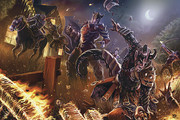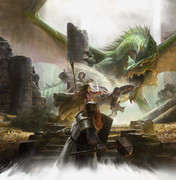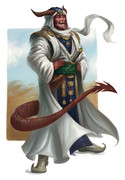Jacob Lewis
Ye Olde GM
This is part of a series about expanding the classic D&D adventure from 4th Edition, Reavers of Harkenwold. I initially started this project on another forum. But after a bit of encouragement and positive response, I've decided to share it here. The first thread of this project can be found here.
Even though I am writing specifically for 4th edition, most of the information here is usable with any version or game system. I don't think I need to explain that, but it seems that people sometimes forget. I hope to convince others that an older edition is still a viable option, no matter which one you prefer. We don't need tools, or support, or permission, if we have the books and the desire to continue enjoying them.
I'd love to have more discussions with those who want to share their ideas and their passion for adventure design, 4th edition, and D&D. Your responses and participation in this thread tell me that there is interest and appreciation for me to continue posting this series.

Introduction
Before I go any further, let me make one thing perfectly clear: I have no qualms about running this adventure as written. It is well written and well designed for what it is. The balance and variety of encounters and challenges make it a fun and exciting experience for everyone. And it shares a lot of the basic elements, plot structures, and design features with another one of my favorite adventures, Red Hand of Doom. Both adventures offer a familiar story line with similar experiences. But Reavers is much more compact. It condenses the same kind of story and adventure that Red Hand does with 5-6 levels in only two. And it does it without feeling rushed or forced. That in itself is impressive to me.
This brings me to what I need from this adventure, and why I want to revise it. Simply put, I want to give my players more story and more adventure. This first campaign arc will become the epic beginning of their own heroic stories. But I also need a stronger connection built into the narrative to set up for the next module that I intend to run. A campaign that feels like an evolving story and keeps the players engaged in what comes next is much better than a string of seemingly random quests, in my opinion. If successful, I will have expanded this adventure without diminishing any of the qualities that I feel make it special. But its going to take more than bigger maps with extra encounters. That's why creating this outline is an important step for me.
Aside from the obvious benefits of being more organized, outlining the adventure will help me stay focused and keep me on track. This is a fairly big project, so it's going to take me some time to finish. An outline serves as a roadmap, showing me where I am, where I want to go, and how I can get there. If I get lost along the way, it'll remind me of important points I made weeks ago or might have forgotten since. The good news is that a lot of the work has already been done for me. If I were creating an adventure from scratch, this would require a lot more thought and planning on my part. But there's still plenty of work for me to do. How much? Let's find out.
Reavers of Harkenwold is organized into two parts, each contained within its own 32-page adventure book. The first half of the adventure takes the characters from 2nd to 3rd level, while the second half is designed to take them from 3rd to 4th level. Following this formula, each character level would require its own 32-page booklet. So if I want to start the characters at 1st level and take them to 6th, then I would need a total of 160 pages. That's 96 more pages than the original adventure, or 150% more content. And I may still need to make some adjustments for those original 64 pages. Sounds intimidating, but I'm not writing to publish a book. Its a D&D campaign, which is measured by a different standard. So let's look at this another way.
The adventure breaks down into five distinct chapters with twenty-two possible encounters. There's an additional encounter at the end of the adventure to be used as an epilogue, but its optional so I'm not counting that. That means eleven encounters for each character level, which is over the expected number needed for a character to gain a level (i.e 8-10 per level). But having adding some extras isn't a bad idea. You can't expect players to find every encounter you place on the map. They might skip an area of a dungeon, ignore clues or quests, or go in a completely different direction than anticipated. Players are like that sometimes. So I will still need 55 encounters, but that's less intimidating than 160 full pages, right? Besides, encounters are easy to make. Especially with 4th Edition.
(Sidebar: This, by the way, is how most of my campaigns are born. I don't have a lot of original material or ideas when it comes to world building or adventure design. That's not my thing. But with all the content and products that I have purchased for my shelves and stored on my hard drives over the last few decades, I don't feel like I should have to. In my experience, players are more interested in playing the game than reading the content. People don't just stop going to theme parks because they've been on all the rides, or stop watching their favorite movies over and over because they know how it ends. As long as the quality is good, and everyone is having fun, no one is going to question whether the ideas are original or fresh. I'm a Game Master, not a writer. There's a good reason for both.)
Part I: The (Original) Adventure Synopsis || Part II: Just Add the Starter Set || Part III: The Revised Synopsis (Part I) || Part IV: Regarding Eladrins, Elves, and Goblins || Part V: TBA
Related Thread Links
========================
Main: Revisiting Reavers of Harkenwold
1: Expanding the Iron Circle || Part I: The Iron Circle || Part II: The Iron Circle (cont.) || Part III: The Fell Court || Part IV: The Ashmadai || Part V: Gardmore Abbey
Last edited:




